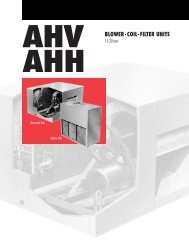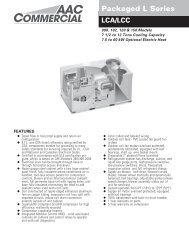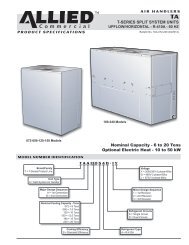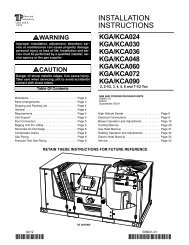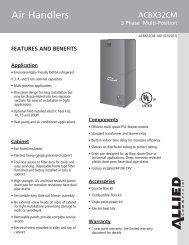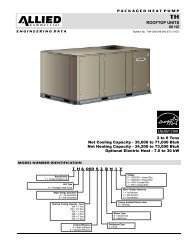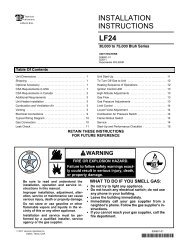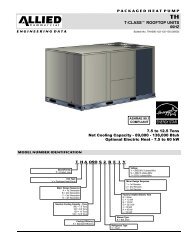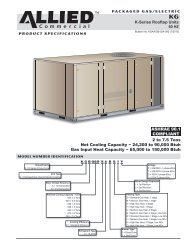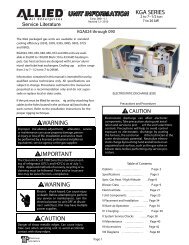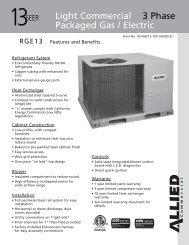K-Series (7.5-12.5 KGA) Installation Instructions - Allied Commercial
K-Series (7.5-12.5 KGA) Installation Instructions - Allied Commercial
K-Series (7.5-12.5 KGA) Installation Instructions - Allied Commercial
You also want an ePaper? Increase the reach of your titles
YUMPU automatically turns print PDFs into web optimized ePapers that Google loves.
6− If discharge pressure is high, remove refrigerant fromthe system. If discharge pressure is low, addrefrigerant to the system. Add or remove charge in increments. Allow the system to stabilize each timerefrigerant is added or removed.7− Use the following approach method along with thenormal operating pressures to confirm readings.TABLE 4<strong>KGA</strong>/KCA092S NORMAL OPERATING PRESSURESOutdoorCoilEnteringAir TempDischarge+10 psigCIRCUIT 1 CIRCUIT 2DischargeSuction+5 psig +10 psigSuction+5 psig65 F 260 130 269 13275 F 301 133 311 13385 F 343 135 354 13695 F 388 138 401 139105 F 435 140 449 141115 F 481 142 497 144TABLE 5KCA/<strong>KGA</strong>102S NORMAL OPERATING PRESSURESOutdoorCoilEnteringAir TempDischarge+10 psigCIRCUIT 1 CIRCUIT 2DischargeSuction+5 psig +10 psigSuction+5 psig65 F 262 128 270 12975 F 299 131 310 13185 F 342 134 353 13495 F 386 137 399 136105 F 434 140 448 139115 F 487 143 501 142TABLE 6KCA/<strong>KGA</strong>120S NORMAL OPERATING PRESSURESOutdoorCoilEnteringAir TempDischarge+10 psigCIRCUIT 1 CIRCUIT 2DischargeSuction+5 psig +10 psigSuction+5 psig65 F 275 135 282 13675 F 313 137 323 13885 F 355 140 366 14195 F 400 142 414 143105 F 447 145 464 145115 F 499 148 517 148TABLE 7KCA/<strong>KGA</strong>150S NORMAL OPERATING PRESSURESOutdoorCoilEnteringAir TempDischarge+10 psigCIRCUIT 1 CIRCUIT 2DischargeSuction+5 psig +10 psigSuction+5 psig65 F 279 132 283 13675 F 318 134 323 13885 F 360 136 364 13995 F 406 138 411 140105 F 456 141 462 142115 F 508 145 515 145Page 18D−Charge Verification − Approach Method−AHRI Testing1− Using the same thermometer, compare liquidtemperature (at condenser outlet) to outdoor ambienttemperature.Approach Temperature = Liquid temperature minusambient temperature.2− Approach temperature should match values shown intable 8. An approach temperature greater than thisvalue indicates an undercharge. An approachtemperature less than this value indicates anovercharge.TABLE 8APPROACH TEMPERATURELiquid Temp. Minus Ambient Temp.Unit1st Stage2nd Stage092 9°F + 1 (5.0°C + 0.5) 8°F + 1 (4.4°C + 0.5)102 7°F + 1 (3.9°C + 0.5) 6°F + 1 (3.3°C + 0.5)120 8°F + 1 (4.4°C + 0.5) 6°F + 1 (3.3°C + 0.5)150 6°F + 1 (3.3°C + 0.5) 6°F + 1 (3.3°C + 0.5)3− The approach method is not valid for grossly over orundercharged systems. Use tables 4 through 7 as aguide for typical operating pressures.C−Compressor ControlsSee unit wiring diagram to determine which controls areused on each unit. Optional controls are identified onwiring diagrams by arrows at junction points.1− Freezestats (S49, S50)Switches de−energize compressors when evaporatorcoil temperature falls below 29°F (−2°C) to preventevaporator freeze−up. Switches reset whenevaporator coil temperature reaches 58°F (15°C).Gas Heat Start−Up (Gas Units)FOR YOUR SAFETY READ BEFORE LIGHTINGWARNINGElectric shock hazard. Can cause injuryor death. Do not use this unit if any parthas been under water. Immediately calla qualified service technician to inspectthe unit and to replace any part of thecontrol system and any gas controlwhich has been under water.WARNINGDanger of explosion. Can cause injuryor product or property damage. If overheatingoccurs or if gas supply fails toshut off, shut off the manual gas valveto the appliance before shutting offelectrical supply.



